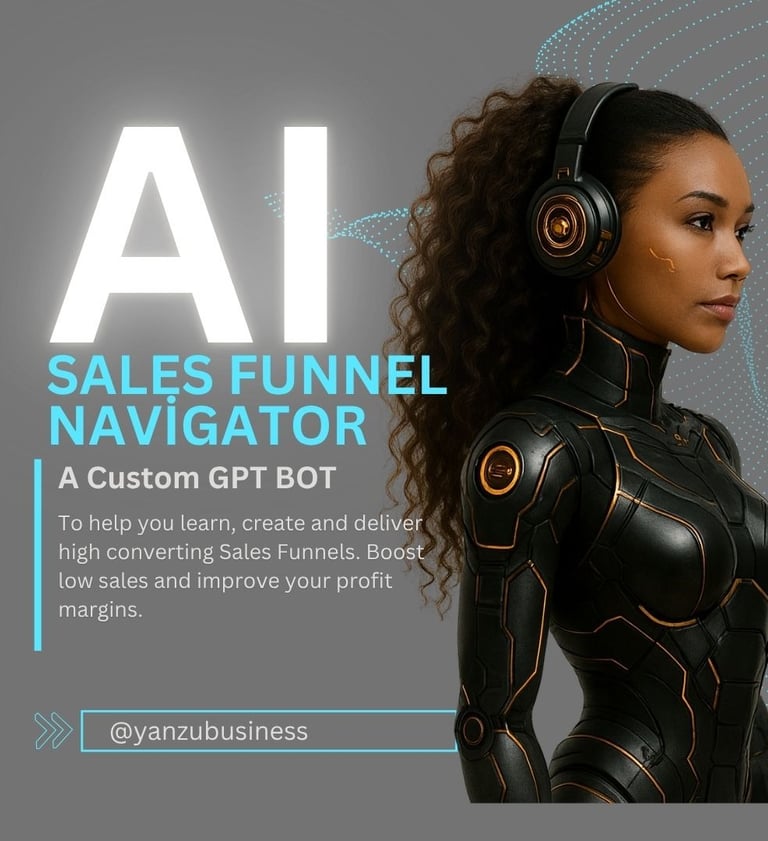Avoiding AI Hype: 7 Red Flags and What to Measure Instead
9/14/202510 min read


What to Measure
In the rapidly evolving landscape of artificial intelligence (AI), small business owners need to be cautious of misleading claims and exaggerated promises. This blog post highlights key red flags related to AI hype and suggests practical metrics to focus on. Here are the five essential takeaways:
Lack of Transparency: Be wary of AI solutions that do not clearly explain how they work or the processes involved. Genuine AI applications should provide insight into their algorithms and decision-making techniques.
Overpromised Outcomes: Caution is advised when faced with claims of instant results or revolutionary impacts. Sustainable AI implementations typically require measured investment in time and resources before realization of benefits.
Ignoring Contextual Relevance: Effective AI solutions are context-dependent. Vendors that dismiss the importance of industry-specific considerations may be overselling their offerings.
Inadequate Evidence of Success: Before committing to an AI solution, seek substantial case studies or empirical evidence demonstrating real-world results. Anecdotal claims should not be the basis of your decision-making.
Metrics for Focus: Instead of getting swayed by hype, small business owners should prioritize metrics such as ROI, customer satisfaction enhancements, and operational efficiency improvements. These concrete measures offer guidance on the actual value of AI tools.
By staying mindful of these red flags and seeking clarity in decision-making based on practical metrics, small business owners can navigate the AI landscape more effectively.
Why Hype Hurts Small Teams
The increasing visibility of artificial intelligence (AI) has prompted a wave of enthusiasm among businesses of all sizes, particularly among small teams and solopreneurs. However, this excitement can often morph into hype, leading to detrimental consequences. The allure of groundbreaking AI solutions can cause small businesses to misallocate resources, time, and money in pursuit of over-promised technologies. The high expectations set by sensationalist narratives can result in significant financial strain, as small teams may invest in tools that ultimately do not deliver on their extravagant claims.
Moreover, the rampant promotion of AI can divert attention from more relevant and practical solutions. Small businesses, often operating with limited budgets and personnel, must allocate their resources wisely. When these teams become enamored with AI buzzwords and trends, they risk overlooking solutions that are both manageable and measurable. Focusing on overhyped technologies can lead to opportunity costs, where valuable time is squandered in the pursuit of unrealistic goals rather than concentrating on immediate priorities that would yield tangible outcomes.
The detrimental impact of AI hype stretches beyond financial losses. It can also deteriorate team morale and hinder productivity. Small teams often thrive on adaptability and focus; however, the constant pressure to adopt the latest technological fads can lead to confusion and fatigue. Rather than leveraging existing resources to enhance performance, small teams might expend energy on integrating overly complex AI tools that complicate their processes without providing proportional benefits. This misalignment of efforts can disrupt workflows, impede progress, and contribute to an environment where team members feel overwhelmed rather than empowered.
Ultimately, for small businesses and solopreneurs, it is essential to remain grounded in the reality of their operational needs. By prioritizing practical, measurable solutions over alluring AI hype, small teams can ensure sustainable growth and effective resource management, paving the way for better long-term outcomes.
Red Flag #1: Overpromised Features
Overpromised features refer to claims made by AI solution providers that suggest their technology can deliver results beyond what is realistically achievable. These inflated promises often paint a picture of a flawless and highly capable system that claims to automate tasks seamlessly, vastly improve decision-making, or yield substantial cost savings with minimal effort. For instance, an AI vendor might advertise their product as a tool that can fully replace human analysts, thereby eliminating the need for skilled personnel. Such claims can be misleading and set unrealistic expectations that are often unattainable in practice.
The risks associated with relying on these overpromised features are significant, particularly for small and medium enterprises (SMEs). With limited resources, SMEs cannot afford to invest time and money into solutions that do not deliver on their lofty promises. When companies base their budgeting and expectations on these exaggerated claims, they may find themselves with technology that fails to meet their business needs or deliver a significant return on investment. This mismatch can lead to frustrations and a lack of trust in AI technologies, potentially stunting further innovation.
Moreover, the reliance on overhyped features can negatively impact long-term strategy. If an SME invests in a product based on the vendor's exaggerated promises, they may become dependent on a subpar solution, hindering their ability to adopt better technologies to meet evolving business demands. Consequently, SMEs should approach AI solutions critically, seeking proof of capabilities and concrete results rather than falling for enticing claims. Understanding the limitations of AI technologies is crucial for making informed decisions that align with organizational goals and sustainable growth.
Red Flag #2: Lack of Clear Metrics
In the rapidly evolving landscape of artificial intelligence (AI), the presence of clear metrics is paramount for assessing the effectiveness and return on investment (ROI) of AI initiatives. A lack of measurable outcomes can often signal a deficiency in the substance of AI offerings, leading organizations astray. Without defined metrics, companies struggle to gauge whether an AI solution is generating tangible value, thereby hindering informed decision-making.
For example, an organization may adopt a cutting-edge AI tool that promises advanced predictive analytics. However, if there are no clear metrics in place to ascertain its impact—such as accuracy rates, error margins, or cost savings—the business is left without a means to quantify the tool’s effectiveness. This ambiguity can lead to inflated expectations and disappointment when the anticipated results fail to materialize.
This concern is particularly acute for small and medium enterprises (SMEs), which often operate with limited resources and budgets. Without precise metrics, SMEs face significant challenges in evaluating the ROI of AI technologies. They may invest in flashy solutions that make grand promises yet deliver little in terms of practical outcomes. Consequently, the financial implications of such ill-informed decisions can be detrimental, leading to wasted resources and missed opportunities for growth.
Moreover, the absence of clear metrics can fuel a cycle of reliance on superficial AI solutions that lack robustness or relevance. SMEs may find themselves drawn to technology providers that present compelling marketing narratives but fail to substantiate these claims with empirical evidence. As a result, organizations must prioritize the establishment of clear, measurable outcomes as part of their AI strategy to avoid falling victim to hype and ensure they are investing in genuinely effective solutions.
Red Flag #3: Exaggerated Case Studies
In the quest to showcase the transformative potential of artificial intelligence (AI), many organizations release case studies that may exaggerate results. These documents often highlight extraordinary successes and rapid returns on investment that can create inflated expectations among stakeholders. However, it is crucial to discern authentic narratives from those that misrepresent the actual impact of AI tools. When examining case studies, one should be cautious of several key indicators of exaggeration.
Consider, for example, a company that claims to have doubled its revenue within a quarter solely due to the implementation of an AI-driven analytics platform. This scenario may sound appealing but merits scrutiny. A deeper investigation may reveal that other factors contributed significantly to this growth—such as market conditions, additional strategic initiatives, or a pre-existing upward trend. Such an inflated portrayal can mislead decision-makers into adopting AI solutions that may not align with their specific business needs, potentially resulting in wasted resources and unmet expectations.
Furthermore, businesses must be wary of cherry-picked success stories that do not adequately represent the challenges faced by most organizations when integrating AI. These case studies often omit critical details, such as implementation timeframes, costs, or hurdles encountered during the process. Relying on such deceptive examples can distract organizations from developing a realistic and tailored AI strategy, which is essential for harnessing the technology's true capabilities.
In light of these concerns, it is vital for companies to critically evaluate the authenticity of case studies pertaining to AI. Scrutinizing the methodology, context, and outcomes presented in these narratives is vital to fostering informed decision-making. By doing so, organizations can create more accurate expectations and align their AI initiatives with actual business objectives, ultimately steering clear of the pitfalls associated with exaggerated claims.
Red Flag #4: Buzzword Overload
In the rapidly evolving landscape of artificial intelligence (AI), the proliferation of buzzwords has become a notable concern. Terms like "machine learning," "deep learning," "neural networks," and "cloud AI" are frequently employed in marketing materials, often to create hype rather than to convey clear, actionable information. This trend can obfuscate the actual capabilities and limitations of AI applications, leaving potential users—especially small and medium-sized enterprises (SMEs)—confused and potentially misled. The excessive use of jargon tends to inflate expectations without providing clear insights into the product’s true functionality or value.
For instance, an AI solution may be marketed as a "revolutionary predictive analytics tool" without offering concrete examples of how it can be applied to real-world situations. Such vague descriptions may lead SMEs to invest significantly in products that promise the moon but deliver little in terms of measurable outcomes. When faced with a barrage of buzzwords, stakeholders may find it difficult to discern the actual benefits or return on investment offered by the technology. This confusion can result in misguided investments that do not align with the company’s strategic goals.
Furthermore, the excessive reliance on buzzwords can lead to a false sense of understanding within organizations. Decision-makers may believe they comprehend the product's capabilities simply because the terminology sounds advanced and sophisticated. This could foster an environment where the actual value of proposed AI investments remains unclear. To mitigate these risks, SMEs should prioritize seeking clarity over jargon and insist on straightforward explanations that detail how AI technology will directly contribute to their operations and objectives.
Red Flag #5: One-Size-Fits-All Solutions
The proliferation of artificial intelligence (AI) solutions has led to a troubling trend: the rise of one-size-fits-all products that claim to meet the diverse needs of various businesses. While these generic solutions may seem appealing due to their often lower price points and purported ease of implementation, they frequently fall short of delivering the value initially promised. Businesses that opt for these uniform AI systems instead of tailored alternatives may encounter significant challenges that undermine their operational efficiency.
For instance, consider a small e-commerce business that chooses a generic inventory management AI software. This solution might function adequately for larger retail environments, but it lacks the customization necessary for smaller operations. Consequently, the e-commerce team could find themselves contending with irrelevant data filters and insufficiently predictive analytics that do not align with their specific customer behaviors or product trends. As a result, the business may waste valuable time navigating an interface designed for a completely different user experience, which ultimately detracts from their focus on growth and customer satisfaction.
Moreover, the absence of customization in AI solutions can lead to wasted resources, especially for small businesses that often operate on tighter budgets. Investing in broad applications that fail to address specific needs can divert critical funds from areas that would yield a better return on investment. Additionally, scalability becomes a pressing concern; the lack of a tailored approach means that as businesses grow, they may find themselves needing to switch platforms entirely, incurring further costs and potential downtime. Therefore, it is essential for organizations to critically evaluate AI solutions, ensuring they align with their unique operational needs and goals instead of succumbing to the allure of convenient, generic products.
Red Flag #6: Lack of Client Support
The implementation of artificial intelligence solutions can be a complex and challenging process, particularly for small businesses lacking extensive technical resources. A critical warning sign that potential AI vendors may not be suitable for a given organization is a lack of adequate client support during and after the implementation phase. Insufficient support can manifest in various forms, such as delayed responses to queries, limited availability of support staff, or a lack of comprehensive training materials. These issues can significantly impede the successful adoption of AI technologies.
For instance, when a small business adopts an AI tool but then faces challenges related to system integration or user training, a vendor with inadequate support may leave the business grappling with unresolved issues. This scenario can lead to significant frustration among employees, who may become disillusioned with the technology if they do not feel adequately supported. Furthermore, the absence of timely assistance can increase the likelihood of failures during critical moments, such as system updates or troubleshooting, resulting in lost productivity and potential financial repercussions.
Another aspect to consider is the post-implementation stage, where ongoing support is crucial to ensure the AI system continues to meet the evolving needs of the business. Vendors who fail to provide sufficient follow-up or maintenance support may leave clients struggling to adapt as their business scales or as new challenges arise. It is essential for small businesses to prioritize partnerships with vendors that demonstrate a commitment to comprehensive client support, as this will facilitate a smoother integration process and foster a more sustainable AI adoption.
By recognizing the signs of inadequate client support, businesses can make more informed choices regarding AI vendors, ultimately safeguarding their investments and ensuring successful technology adoption. Being proactive in assessing vendor support levels is crucial for any organization looking to integrate AI effectively.
Red Flag #7: Aggressive Sales Tactics
In the rapidly evolving landscape of artificial intelligence, small and medium-sized enterprises (SMEs) are often targeted by vendors employing aggressive sales tactics. These strategies can manifest as high-pressure sales techniques designed to close deals swiftly, often without allowing potential clients the necessary time for deliberation or thorough evaluation of their specific needs. Vendors may employ limited-time offers, exaggerated claims of benefits, or assertive follow-ups that create an environment of urgency surrounding the purchasing decision.
This kind of selling can lead to hasty decisions that do not align with a business's long-term strategic interests. For instance, an SME might feel compelled to adopt a particular AI solution simply to avoid missing out on a supposedly advantageous deal. Such decisions are often based on superficial assessments, neglecting to consider crucial factors such as integration with existing systems, scalability, and the potential return on investment.
Moreover, aggressive sales tactics can obscure the true capabilities and limitations of the product in question. Vendors may overstate their offerings, focusing on impressive features while downplaying risks or shortcomings. An SME might invest heavily in a system that ultimately fails to deliver the promised benefits, resulting not only in wasted resources but also in opportunity costs, as critical time and funds are directed away from more viable solutions.
It is essential for businesses to recognize these red flags and take a measured approach when engaging with AI vendors. A careful assessment of their own requirements and a thorough review of the vendor's claims can prevent unnecessary financial strain. Engaging in discussions with multiple vendors can further enhance decision-making processes, allowing companies to navigate the market of AI solutions more effectively, ensuring alignment with their unique objectives.








Sales Funnels with AI.
Increase customer engagement with effective sales Funnels powered with the help of AI.


